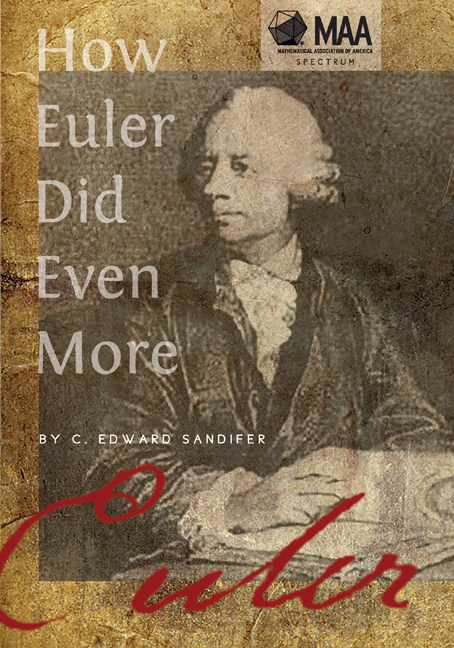Book contents
- Frontmatter
- Contents
- Preface
- Part I Geometry
- Part II Number Theory
- Part III Combinatorics
- Part IV Analysis
- 12 e, π and i: Why is “Euler” in the Euler Identity (August 2007)
- 13 Multi-zeta Functions (January 2008)
- 14 Sums of Powers (June 2009)
- 15 A Theorem of Newton (April 2008)
- 16 Estimating π (February 2009)
- 17 Nearly a Cosine Series (May 2009)
- 18 A Series of Trigonometric Powers (June 2008)
- 19 Gamma the Function (September 2007)
- 20 Gamma the Constant (October 2007)
- 21 Partial Fractions (June 2007)
- 22 Inexplicable Functions (November 2007)
- 23 A False Logarithm Series (December 2007)
- 24 Introduction to Complex Variables (May 2007)
- 25 The Moon and the Differential (October 2009—A Guest Column by Rob Bradley)
- Part V Applied Mathematics
- Part VI Euleriana
- About the Author
25 - The Moon and the Differential (October 2009—A Guest Column by Rob Bradley)
from Part IV - Analysis
- Frontmatter
- Contents
- Preface
- Part I Geometry
- Part II Number Theory
- Part III Combinatorics
- Part IV Analysis
- 12 e, π and i: Why is “Euler” in the Euler Identity (August 2007)
- 13 Multi-zeta Functions (January 2008)
- 14 Sums of Powers (June 2009)
- 15 A Theorem of Newton (April 2008)
- 16 Estimating π (February 2009)
- 17 Nearly a Cosine Series (May 2009)
- 18 A Series of Trigonometric Powers (June 2008)
- 19 Gamma the Function (September 2007)
- 20 Gamma the Constant (October 2007)
- 21 Partial Fractions (June 2007)
- 22 Inexplicable Functions (November 2007)
- 23 A False Logarithm Series (December 2007)
- 24 Introduction to Complex Variables (May 2007)
- 25 The Moon and the Differential (October 2009—A Guest Column by Rob Bradley)
- Part V Applied Mathematics
- Part VI Euleriana
- About the Author
Summary
Euler's output was split fairly evenly between pure and applied mathematics, the latter including many topics that we would today classify as physics. Most of his papers fall decisively into one category or the other, but it wasn't at all rare for one of his works of applied mathematics to include new techniques or results in analysis. This frequently happened in the Paris Prize competition, for example, where the questions were generally of a practical nature. This month, we'll look at an astronomical paper [E401] that proposes numerical techniques for approximating a body's velocity and acceleration. Remarkably, one of the results in E401 was probably the first step in the development of the calculus of operations and seems to have influenced Lagrange's foundational program for the calculus.
Euler read E401, “A New Method for Comparing Observations of the Moon to the Theory,” to the Berlin Academy on February 6, 1766, just a few months before his return to St. Petersburg. Because he quoted astronomical data from the summer of 1765, it's nearly certain that his results date that year. Nevertheless, the paper appeared in the Berlin Academy's volume for 1763, which was only published in 1770. Euler probably had it included in this volume, despite its later composition date, because it's a follow-up to E398, “A New Method for Determining the Perturbations in the Motion of Heavenly Bodies Caused by their Mutual Attraction,” which he read to the Academy on July 8, 1762. Because of the long publication delay in the 1763 volume, Euler was able to arrange matters so that E398 was immediately followed by three papers that build upon it results: E399, read on December 18, 1763, which applies the methods E398 to the moon, E400, read on December 4, 1765, which considers the general three body problem, and E401.
- Type
- Chapter
- Information
- How Euler Did Even More , pp. 166 - 172Publisher: Mathematical Association of AmericaPrint publication year: 2014



